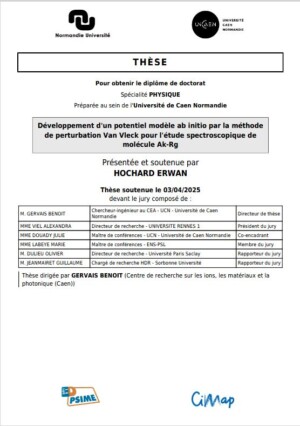Résumé :
Dans cette thèse, nous développons un modèle potentiel ab initio basé sur la méthode de perturbation de Van Vleck pour l’étude spectroscopique des molécules de type alcalin-gaz rare (Ak-Rg). En combinant la théorie des perturbations avec des méthodes avancées de modélisation, nous construisons des potentiels d’interaction précis permettant d’analyser la structure électronique et les propriétés spectroscopiques des complexes moléculaires étudiés. Une attention particulière est portée à la corrélation cœur-valence et aux effets relativistes, essentiels pour une description rigoureuse des interactions interatomiques impliquant des atomes lourds. Nous explorons l’applicabilité du modèle dans le contexte de la spectroscopie des états excités, en mettant en avant les niveaux vibrationnels et les transitions électroniques des molécules Ak-Rg. Les résultats obtenus sont comparés aux données expérimentales et aux calculs ab initio existants, soulignant la pertinence et la précision de la méthode développée. Cette approche ouvre de nouvelles perspectives pour la modélisation des interactions complexes dans les systèmes moléculaires impliquant des alcalins et des gaz rares.
Mots-clés : Perturbation de Van Vleck, Pseudo-Potentiel.
Development of a potential ab initio Model using the Van Vleck perturbation method for the spectroscopic study of ak-rg molecules
Abstract:
Atom Probe Tomograpgy (APT) is an experimental metrology tool intended to explore atomic arrangement in solids. Its working principle is field emission used to evaporate atoms from the sample surface, which is given a needle shape. The simulation work presented in this thesis takes place in the APT framework and is dedicated to better understanding of field emission. We focus on silicon carbide (SiC) as a typical semiconductor often studied in APT.To perform a relevant simulation, in is necessary to consider a large number of atoms while keeping the physico-chemical specificities of the material at a good level of description.
In this thesis, we develop an ab initio potential model based on Van Vleck perturbation theory for the spectroscopic study of alkali–rare gas (Ak-Rg) molecules. By combining perturbation theory with advanced modeling methods, we construct accurate interaction potentials to analyze the electronic structure and spectroscopic properties of the studied molecular complexes. Special attention is given to core-valence correlation and relativistic effects, which are crucial for a rigorous description of interatomic interactions involving heavy atoms. We explore the applicability of the model in the context of excited-state spectroscopy, emphasizing the vibrational levels and electronic transitions of Ak-Rg molecules. The obtained results are compared with experimental data and existing ab initio calculations, highlighting the relevance and accuracy of the developed method. This approach opens new perspectives for modeling complex interactions in molecular systems involving alkali and rare gas elements.
Keywords: Methodology, Spectroscopy, Van Vleck Perturbation, Pseudo-Potential.


